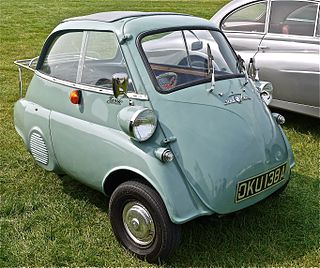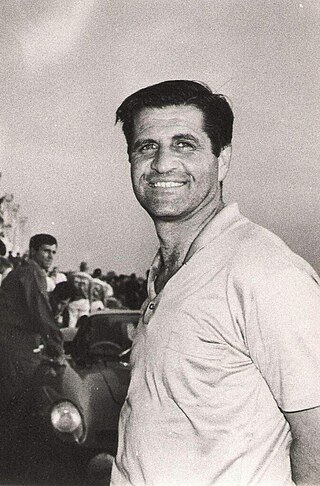
The Isetta is an Italian-designed microcar built under license in a number of different countries, including Argentina, Spain, Belgium, France, Brazil, Germany, and the United Kingdom. Because of its egg shape and bubble-like windows, it became known as a bubble car, a name also given to other similar vehicles.

ASA was an Italian automobile manufacturer active from 1961 to 1969, who is known for manufacturing the ASA 1000 GT. This car was developed by Ferrari engineers in the late 1950s as a less expensive, compact alternative to existing Ferrari GT cars. ASA used inline-four and straight-six engines derived from the "250" 3-litre V12 designed by Gioacchino Colombo. The chassis was developed by Giotto Bizzarrini and was derived from the tubular frame chassis of the 250 GTO.

The Ferrari 250 GTO is a grand tourer produced by Ferrari from 1962 to 1964 for homologation into the FIA's Group 3 Grand Touring Car category. It was powered by Ferrari's Tipo 168/62 Colombo V12 engine.

A transaxle is a single mechanical device which combines the functions of an automobile's transmission, axle, and differential into one integrated assembly. It can be produced in both manual and automatic versions.

The Ferrari 250 is a series of sports cars and grand tourers built by Ferrari from 1952 to 1964. The company's most successful early line, the 250 series includes many variants designed for road use or sports car racing. 250 series cars are characterized by their use of a 3.0 L (2,953 cc) Colombo V12 engine designed by Gioacchino Colombo. They were replaced by the 275 and 330 series cars.

ISO Rivolta is an Italian car and motorbike manufacturer active in the motor vehicle sector since 1938. Over the years, the company has taken various names, including Isothermos, Iso Autoveicoli Spa in 1952, Iso Rivolta in 1962, Iso Motors in 1973 and, in 2017, a return to ISO Rivolta.

Bizzarrini S.p.A. was an Italian automotive manufacturer founded by Giotto Bizzarrini an Italian engineer born in Livorno, Tuscany in 1926 and died on May 13 2023: in 1964 the automotive company was founded by former Alfa Romeo, Ferrari and Iso engineer Giotto Bizzarrini. The company built a small number of highly developed and advanced sport and racing automobiles before failing in 1969: in 2020, it was announced that the name had been acquired by Pegasus brands, together with plans to restart production.

Giotto Bizzarrini was an Italian automobile engineer who was active from the 1950s through the 1970s.

The Bizzarrini Strada, is a sports car produced by Bizzarrini from 1964 to 1968. Sold as an exceptionally low slung, two-seat coupé, roadster, and track-tuned "Corsa" racer, it proved to be Bizzarrini's most successful model.

The Ferrari 250 GT SWB Breadvan is a one-off Ferrari made in 1962 from a 1961 Ferrari 250 GT Berlinetta SWB, chassis number 2819 GT. It was built to compete against the new 1962 Ferrari 250 GTO at the 24 Hours of Le Mans and other FIA World Sportscar Championship races.

The Lamborghini Espada is a 4-seat grand touring coupé built by Italian car manufacturer Lamborghini between 1968 and 1978.

The Chevrolet Corvette (C1) is the first generation of the Corvette sports car produced by Chevrolet. It was introduced late in the 1953 model year and produced through 1962. This generation is commonly referred to as the "solid-axle" generation, as the independent rear suspension did not appear until the 1963 Sting Ray.

The Iso Grifo is a limited production grand tourer manufactured by Italian automobile manufacturer Iso Autoveicoli S.p.A. between 1965 and 1974. Intended to compete with Grand Touring offerings from Ferrari and Maserati, it used a series of American power trains and components supplied by Chevrolet and Ford. Styling was done by Giorgetto Giugiaro at Bertone, while the mechanicals were the work of Giotto Bizzarrini.

The Iso Lele is a grand tourer that was produced by the Italian automobile manufacturer Iso Automoveicoli S.p.A. between 1969 and 1974. The Lele, being a 2+2-seater, filled the gap between the Grifo and the Fidia while sharing its powertrain with its siblings. The styling was done by Marcello Gandini of Bertone. The car is named after Lele Rivolta, wife of Piero Rivolta.

Renzo Rivolta was an Italian Engineer.

A dual-clutch transmission (DCT) is a type of multi-speed vehicle transmission system, that uses two separate clutches for odd and even gear sets. The design is often similar to two separate manual transmissions with their respective clutches contained within one housing, and working as one unit. In car and truck applications, the DCT functions as an automatic transmission, requiring no driver input to change gears.

The Volvo 262C is the first luxury coupé made by Volvo, after the four-cylinder P1800. Based on the 264 six-cylinder saloon, the 262C was designed in-house by Volvo's Jan Wilsgaard, but largely built by Bertone in Turin for the 1977-1981 model years.
Neri and Bonacini, also known as Nembo, was a small carrozzeria and mechanic shop based in Modena, Italy, active from the late 1950s to around 1967. Founded and run by Giorgio Neri and Luciano Bonacini, the shop worked on and produced bodies for Ferrari, Lamborghini and Maserati road and race cars, both in an official capacity for those manufacturers and for private owners. Their best known projects are the Ferrari 250 GT-based Nembo spiders and the Lamborghini 400GT Monza. Neri and Bonacini also designed a car under their own name, the Neri and Bonacini Studio GT Due Litri. Two prototypes of this car were made between 1966 and 1968 but it never entered series production. The shop closed around 1967 when Bonacini went to work for De Tomaso and Neri started his own shop, Motors-World-Machines (MWM).

The Innocenti 186 GT is a sports car jointly developed by Italian car manufacturers Innocenti and Ferrari in 1963–64, but never put into production. Just two prototypes were ever built, and one survives today.

The AMC AMX/3 is a mid-engine sports car made by American Automobile manufacturer American Motors Corporation (AMC), which was presented in March 1970 and was to be mass-produced in Germany by Karmann from 1971. With this car, AMC wanted to counter the similarly designed De Tomaso Pantera with a competitor. The body design and drivetrain all were developed by and came from AMC, with the chassis and suspension saw development with AMC-consulted and partnering Italian suppliers. The design was originally falsely attributed to Giotto Bizzarrini, however, only some individual components such as parts of the suspension actually came from him. In addition to Bizzarrini, Italdesign, Autocostruzioni S.D. were also involved in the development. The vehicle eventually never reached mass production when, shortly after the official presentation, AMC abandoned the project without giving any reason after about half a dozen cars had already been made. Several attempts to revive the design and license it for a limited production still without AMC's involvement under the Bizzarrini brand name as the Bizzarrini Sciabola were unsuccessful. Later an AMC AMX/3 chassis formed the technical basis for the Iso Varedo concept car in 1972.





















